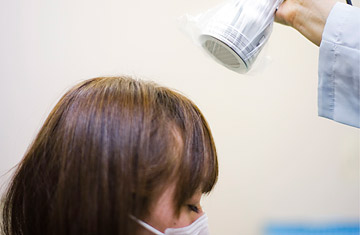
A woman in Yonezawa waits to learn if she has absorbed radiation and if so, how much
(3 of 4)
A fire just like that began on March 15, but to the surprise of engineers, it started in Reactor 4, which had not been in operation. The fire crept up quietly because the cooling pool is 45 ft. (14 m) deep but the rods were stored in the bottom 15 ft. (4.8 m), meaning 30 ft. (9.6 m) of water had to bubble away first. The building remained intact as the fire raged, but the radioactivity spewing from it was what led to the last expansion of the danger that same day. Emergency workers were able to extinguish the blaze, but the alarm prompted Prime Minister Naoto Kan to take to the airwaves and appeal for calm while admitting there was "a further risk of more radioactive material coming out."
There was still more bad news. Engineers concluded that the explosions of the reactor buildings breached the containment vessels in Reactors 1 and 3, as well as the torus — an enclosed doughnut of water around the base of the vessel — in Reactor 2. Not good. "If the primary containment vessel is leaking, then a core meltdown could lead to a very high release of radioactivity into the environment," says physicist David Wright, co-director of the U.S.-based Union of Concerned Scientists.
Too Much for Comfort
Meltdowns, in the sense of overheated fuel starting to soften and sink, are almost certainly under way in all three of the previously active reactors. The 50 workers left at the plant — who on March 16 were joined by 130 more — are fighting to prevent things from getting worse by pumping seawater mixed with boron through fire hoses into release valves in the containment vessels. Boron helps absorb neutrons, reducing radioactivity, and the seawater performs the cooling. The race is to bring the temperature under control before the fuel simply pools on the vessel's floor, reducing the surface area that can be reached by the water. That would make it impossible to lower the temperature, which by then would be above 3,500°F (1,900°C). Ultimately, the fuel could simply burn through the floor and contaminate the ground and water table below. Rising heat and pressure could also cause the containment vessel to rupture. All that is still a possibility, but Bergeron sees some small cause for optimism. "They've had several days, and that's certainly an advantage," he says. "Every day is one more day in the decay curve of the heat. They start to need less and less water to do the cooling."
This small comfort is offset by the fact that as the reactors seem to pose a slightly smaller risk, the coolant-pool problem may be worsening. At a congressional hearing on March 16, Nuclear Regulatory Commission chairman Gregory Jaczko testified that he believes all the water in the Reactor 4 pool has boiled away. That would lead to massive gamma-radiation output.
"The dose rates are probably off the charts if the pool is drained," says Robert Alvarez, a former senior policy adviser at the Department of Energy. "These pools have become the jokers in the deck." All the more so because each of the Fukushima reactors — damaged or not — has one. In response to this latest development, the U.S. embassy recommended that Americans in the vicinity observe a 50-mile (80 km) evacuation zone. Alvarez would go further. "I'd get my butt on an airplane and get out of Japan," he says.
Even if the radiation is quickly contained, there's already been too much for most people's comfort. Radiation levels are measured in rems — for "roentgen equivalent man." The average background exposure that most people absorb simply by living on earth is 2.4 millisieverts (mSv, or one-thousandth of a rem) per year. "It could account for some of the cases of cancer that appear in the general population that have no other evident causes, like smoking," says Dr. Ira Helfand, a board member at Physicians for Social Responsibility. Medical procedures carry their own radiation load. A CT scan, for example, can expose you to about 10 mSv. In most cases, though, the benefits exceed the dangers.
